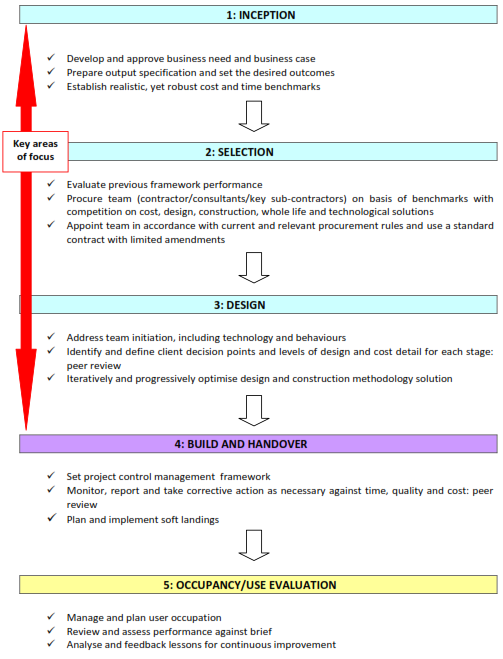Cost led procurement
Contents |
[edit] Introduction
The main aims of the Government Construction Strategy were to ‘change the relationship between Clients and Industry’ and achieve a 15-20% reduction in public sector construction costs by 2015. The Government Construction Task Group report 2012 developed three potential new strategies to help achieve these aims:
- Cost Led Procurement (CLP).
- Integrated Project Insurance (IPI).
- Two Stage Open Book.
All three involve early contractor involvement, transparency and integration. Along with a reduction in costs, they are expected to contribute to a reduction in project risk, improved programme accuracy and an enhanced working relationship between client and the supply chain.
[edit] Background
The Cost Led Procurement method is ‘...intended to allow industry to use its experience and knowledge to develop innovative solutions through leveraging design, materials, subcontracting, direct labour and experience to the advantage of the Public Sector Client...focused on achieving target costs whilst maintaining, if not improving value’ (Cabinet Office, 2014).
In Cost Led Procurement, the project details are clearly identified and a ceiling cost calculated. Typically, an integrated supply team (one or more) is identified through a framework agreement and the team work together to complete the project at below the ceiling cost. In subsequent similar projects within a framework, Cost Led Procurement offers the opportunity for further reduction of costs.
The project is offered to suppliers outside the framework if none of the existing teams are able to deliver the project below the ceiling cost.
[edit] Structure
The CLP plan involves five phases:
- Inception.
- Selection of contractor.
- Design and cost development.
- Construction.
- Operation
The flow chart from the 2014 Cabinet Office publication, Cost Led Procurement Guidance outlines the process.
[edit] Trial projects
Two trial projects were run using the CLP method: Upper Mole and Rye Harbour. The Rye Harbour scheme was successful in achieving a 6% saving through reducing the project programme.
This article contains public sector information licensed under the Open Government Licence v2.0 ref Cabinet Office, Cost Led Procurement Guidance 2014.
[edit] Related articles on Designing Buildings Wiki
- Framework agreement.
- Government construction strategy.
- Integrated project insurance.
- Integrated supply team.
- Managing the procurement process.
- Optimised contractor involvement.
- Procurement route.
- Supply chain.
- Supply chain management.
- Sustainable procurement.
- The benefits of e-procurement in construction.
- Two stage open book.
- Value for money.
[edit] External references
Featured articles and news
Infrastructure that connect the physical and digital domains.
Harnessing robotics and AI in challenging environments
The key to nuclear decommissioning and fusion engineering.
BSRIA announces Lisa Ashworth as new CEO
Tasked with furthering BSRIA’s impressive growth ambitions.
Public buildings get half a million energy efficiency boost
£557 million to switch to cleaner heating and save on energy.
CIOB launches pre-election manifesto
Outlining potential future policies for the next government.
Grenfell Tower Inquiry announcement
Phase 2 hearings come to a close and the final report due in September.
Progress from Parts L, F and O: A whitepaper, one year on.
A replicated study to understand the opinion of practitioners.
ECA announces new president 2024
Electrical engineer and business leader Stuart Smith.
A distinct type of countryside that should be celebrated.
Should Part O be extended to existing buildings?
EAC brands heatwave adaptation a missed opportunity.
Definition of Statutory in workplace and facilities management
Established by IWFM, BESA, CIBSE and BSRIA.
Tackling the transition from traditional heating systems
59% lack the necessary information and confidence to switch.
The general election and the construction industry
As PM, Rishi Sunak announces July 4 date for an election.
Eco apprenticeships continue help grow green workforce
A year after being recognised at the King's coronation.
Permitted development rights for agricultural buildings
The changes coming into effect as of May 21, 2024.






















